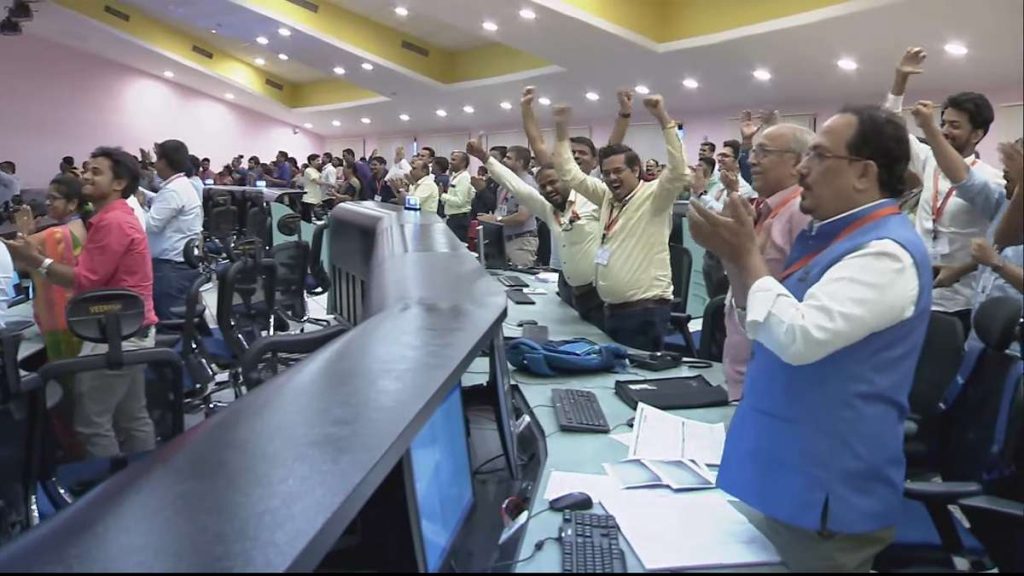India’s Plans and Vision for the Dawning Space Era
India’s Strategic Goals and Mission for Space
Over the next 50 to 100 years, India’s vision in the space industry is to become a global leader, focusing on advanced lunar and interplanetary missions, including manned ventures to the Moon and Mars. The country is committed to developing cost-effective, reliable space technologies for satellite communication, Earth observation, and deep space exploration. India also aims to use space advancements for socio-economic benefits like disaster management and resource mapping. Promoting a robust domestic space industry, fostering international collaborations, and investing in sustainable space technologies, such as reusable launch vehicles, are key priorities. Ultimately, India seeks to harness space’s potential not only for exploration but also to improve life on Earth.

Scientists celebrate at the control room of the Indian Space Research Organisation (ISRO) headquarters, Bengaluru, after completion of India’s third moon landing on Wednesday, 23 August 2023.
In line with this vision, India’s space industry is rapidly advancing, showcasing its skill in technology and innovation as it makes a mark on the global stage of space exploration.
Indian Space Research Organisation (ISRO)’s visionary roadmap, showcasing ambitious missions like Gaganyaan and Chandrayaan-3, marks a significant leap in India’s space exploration efforts. ISRO is renowned for cost-effective and groundbreaking missions such as the Mars Orbiter Mission (Mangalyaan) and the Chandrayaan lunar exploration series. The Gaganyaan, India’s first manned space mission, is poised to make history by sending Indian astronauts into space aboard the reliable LVM3 rocket, which features a robust combination of solid, liquid, and cryogenic stages. This mission not only demonstrates India’s advanced technological capabilities but also its commitment to fostering scientific progress and self-reliance.
The ambitious moon landing missions, Chandrayaan-1in 2008 and Chandrayaan-2 in 2019, have put India on the map of lunar exploration. Chandrayaan-1’s discovery of water molecules on the moon’s surface was a significant milestone. Chandrayaan-2, aimed at further exploring the lunar surface and gathering data on the moon’s topography, mineralogy, and exosphere, has heightened India’s profile in space exploration. The Chandrayaan-3 mission in 2023, featuring an indigenous Lander module, a Propulsion module, and a Rover, aimed to perform a soft landing near the lunar south polar region and carry out high-precision experiments using its sophisticated instruments. The primary goal is to develop and demonstrate new technologies essential for future interplanetary missions, thereby solidifying India’s position as a frontrunner in space technology and exploration.
As ISRO forges ahead with these groundbreaking missions, it continues to push the boundaries of human knowledge and opens new frontiers for global space exploration. For effective communication, the mission will rely on ISRO’s deep space antenna in India and support from international ground stations coordinated by ESA and NASA. This global collaboration, involving ESA’s ‘Estrack’ network and antennas in French Guiana and the UK, as well as NASA’s Deep Space Network, ensures continuous tracking, command, and data reception from the spacecraft. The international ground station support not only cuts costs but also fosters international collaboration in space exploration. Data from Chandrayaan-3, routed through these stations, will be sent to ISRO for analysis, ensuring the mission’s success in exploring the lunar surface.
Strategic Partnerships and Emerging Pioneers
Along with India’s greater ambitions in space, there has also been a significant increase in collaborations between ISRO and other national and international companies over the years. ISRO and SpaceX have teamed up for satellite launches. SpaceX’s Falcon 9 rockets have been used to launch Indian satellites, demonstrating international cooperation. Airbus Defence and Space and ISRO have partnered in various capacities, from satellite launches to technological collaboration. Airbus has provided support in areas like satellite navigation, fostering a mutually beneficial relationship. India’s space sector is further boosted by the emergence of startups and private companies, driven by the government’s initiative to open up the industry. Skyroot Aerospace, an Indian space-tech company, has raised a record $27.5 million in pre-Series C funding, led by Temasek, boosting its total capital to $95 million, the highest for any Indian space-tech startup. This investment will accelerate Skyroot’s growth, focusing on infrastructure, technology, talent, and launch capabilities. In November 2022, Skyroot launched South Asia’s first privately developed rocket, demonstrating India’s private sector’s capabilities in the space launch market. The company, which has an MoU with ISRO for access to expertise and facilities, is positioned to address the global market for small and medium-sized satellites with cost-effective, dependable services. Startups like Bellatrix Aerospace and Dhruva Space are known for their innovations in spacecraft propulsion systems and satellite development, respectively.
The ecosystem of the industry thrives with the substantial involvement of leading companies. Hindustan Aeronautics Limited (HAL) contributes its deep aerospace knowledge to produce components for satellites and rocket launchers, while Larsen & Toubro (L&T), a major force in engineering, constructs vital parts necessary for space missions. In this vibrant ecosystem, Godrej Aerospace is known for crafting highly precise and top-quality components for rocket engines. Meanwhile, Tata Advanced Systems engages in developing missile technology and space infrastructure, and Walchandnagar Industries specializes in engineering gears and crucial elements for rocket launches, further enriching the industry’s ecosystem with their expertise and innovation.
2024: A Landmark Year for ISRO with Pioneering Missions and Global
In 2024, the Indian Space Research Organisation (ISRO) is to redefine space exploration with an impressive lineup of missions, demonstrating its expanding capabilities and fostering international cooperation. The year will witness the launch of the NASA-ISRO Synthetic Aperture Radar (NISAR), a joint venture with NASA to deploy a sophisticated dual-frequency synthetic aperture radar satellite for Earth observation. Alongside NISAR, the INSAT 3DS satellite, a part of the Indian National Satellite System, is scheduled for launch, aimed at enhancing weather monitoring and disaster management. The Gaganyaan 1 mission, a collaboration between ISRO and Hindustan Aeronautics Ltd (HAL), marks a monumental step towards India’s manned space missions, planning to host three crew members in its early 2024 test flight. Following the success of its first mission, Mangalyaan-2 is set to embark on a detailed study of Mars, focusing on its surface, atmosphere, and climate. The X-ray Polarimeter Satellite, scheduled for the same year, aims to unlock mysteries of cosmic X-ray polarisation, with a planned operational period of at least five years. Shukrayaan-1, ISRO’s ambitious venture to Venus, intends to scrutinize the planet’s atmosphere over a five-year orbital period, with a launch window set for late 2024 or 2025. Further enriching the year’s agenda, Oceansat-3A will advance oceanography and atmospheric studies, continuing the legacy of its forerunners. ISRO is also preparing for autonomous runway landing trials of winged body Reusable Launch Vehicles (RLV), showcasing its commitment to innovating cost-effective space access. Complementing these missions, ISRO’s schedule includes six Polar Satellite Launch Vehicle (PSLV) missions, three Geosynchronous Satellite Launch Vehicle (GSLV) missions, and one commercial mission using the Launch Vehicle Mark-3 (LMV-3), alongside advanced experiments with a winged body reusable launch vehicle, underlining its determination to leverage space technology for wide-ranging social and economic benefits.
Implications for the International Procurement Community
The affordability of India’s space solutions, particularly in satellite launches and component manufacturing, allows for significant cost savings and offers an attractive alternative in the global market. The reliability of India’s launch services, backed by a history of successful missions, provides a dependable option for sending various payloads into space. This reliability, combined with the emerging private sector in space technology, introduces fresh dynamics and innovative products into the global space industry, expanding the range of available services. Furthermore, India’s advancements in space technology open avenues for international technological collaborations and joint ventures, particularly in areas such as propulsion systems, satellite fabrication, and deep space exploration. Engaging with India’s space industry also offers the international procurement community an opportunity to diversify their supply chains, enhancing flexibility and risk management. The conducive regulatory environment in India, marked by initiatives to encourage private participation and international partnerships, creates a favourable landscape for global procurement contracts and collaborations. Additionally, India’s strong focus on STEM education ensures a steady stream of skilled professionals, providing a valuable resource for the international space industry.


